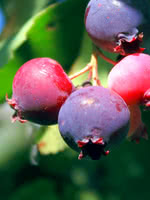Mon-Fri 9am - 5pm Mountain time
Smoky Saskatoon (Serviceberry) vs Grouseberry
Vaccinium scoparium
Amelanchier alnifolia Smoky
CUSTOM GROW
Grouseberry is a native, low-growing deciduous shrub known for its edible red berries. In early summer, it produces small, urn-shaped flowers ranging from white to pink that attract bees and other pollinators. The berries provide an important food source for many types of wildlife, including game birds such as grouse, which gives the plant its common name. People can also enjoy the berries fresh or in baked goods, though they can be difficult to harvest in large quantities.
Spreading by rhizomes, Grouseberry forms dense, broom-like mats that help stabilize soil and prevent erosion, while also providing cover for ground-nesting wildlife. It is commonly found beneath conifers in open forests, subalpine meadows, and occasionally on rocky slopes in mountainous regions. It is well-suited for naturalization, ecological restoration, and soil stabilization projects.
Smoky Saskatoon is a large deciduous shrub that suckers and produces edible fruit. Smoky Saskatoons are one of the most productive and widely used Saskatoons and have large sweet berries with good yields.
One of the oldest and first good yielding cultivars, a majority of the commercial saskatoon orchards were based on this cultivar until Northline and other cultivars were introduced.
Smoky has slightly smaller fruit than Northline and a milder taste but is not acidic like Pembina, Thiessen or Honeywood.

